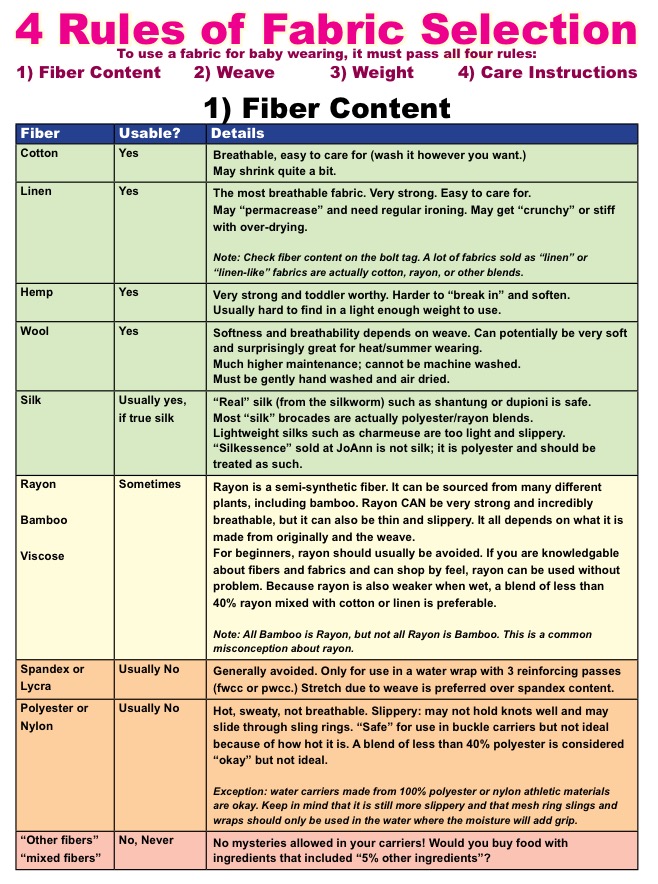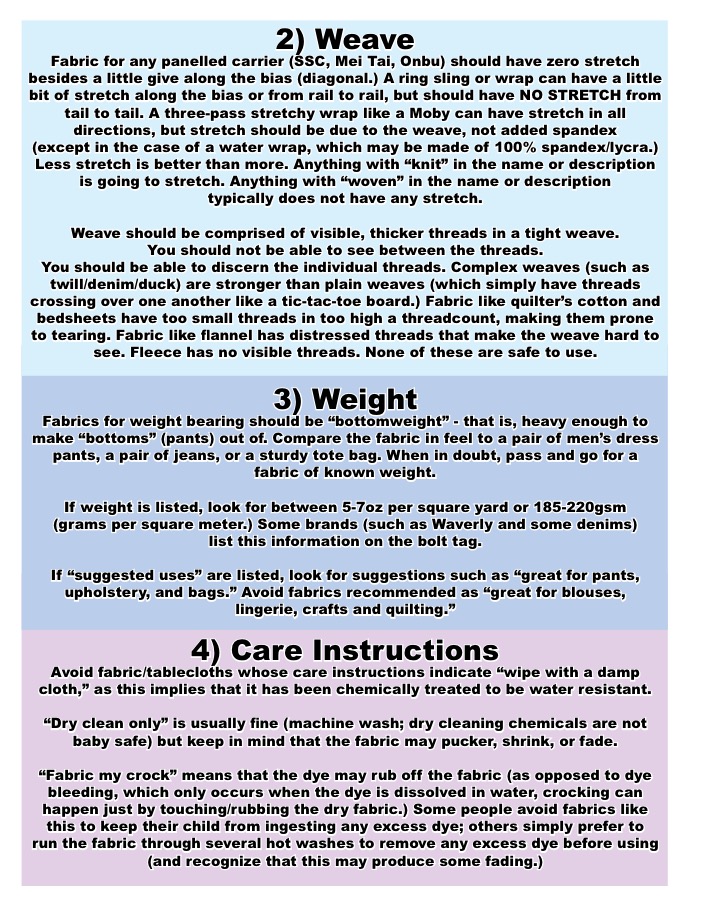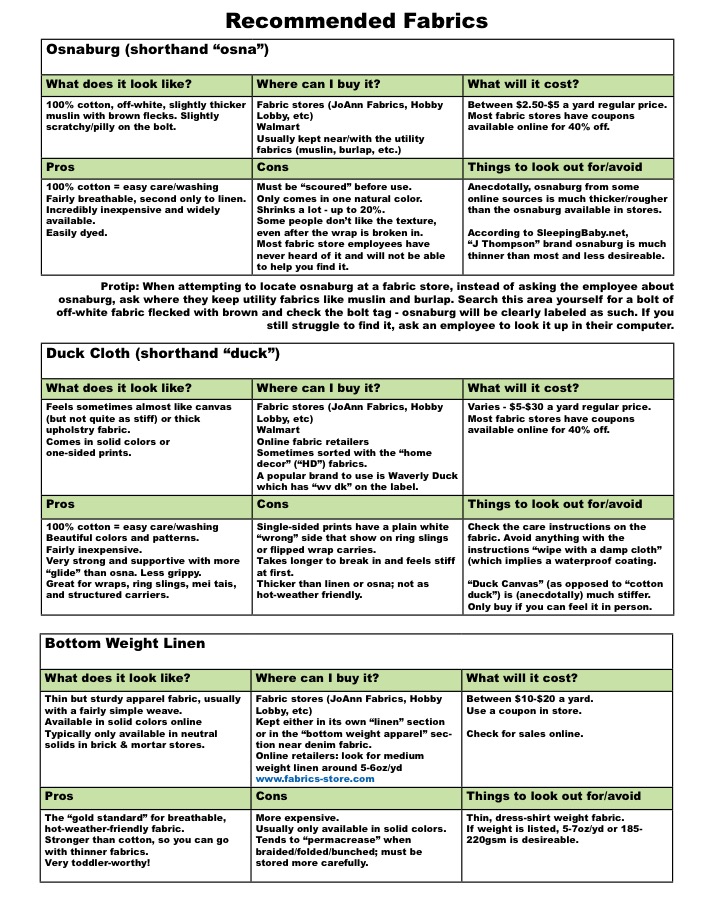Selecting Safe Fabric For Babywearing
Any fabric used for babywearing should pass 4 simple rules for fabric selection. It must pass all four - if it fails just one rule, it should not be used. If you still feel overwhelmed by choosing a fabric based on these four rules, look for one of the "suggested fabrics" listed after the 4 Rules - just always go back to compare it to the 4 Rules to be sure. The Four Rules of Fabric Selection- Fiber Content - Natural Fibers
- Weave - Woven without stretch, thick visible fibers
- Weight - Thick like denim or a sturdy tote bag
- Care instructions - machine washable
4 Rules of Fabric Selection
Rule 1: Fiber Content
The "fiber content" of the fabric is what the threads are made from. This information should be listed on the bolt tag (or package, in the case of a tablecloth) in the form of percentages. It might say something like "100% cotton" or "55% linen, 45% rayon."| Fiber Type | Recommended? | Details | Exceptions |
|---|---|---|---|
| Cotton | Yes | Cotton is a common, inexpensive fiber. It is usually breathable and easy to care for. It will, however, shrink quite a bit, so always buy 20% extra. | n/a |
| Linen, Flax | Yes | Linen is a very strong fiber and, depending on the weave, typically the most breathable fiber for the heat. It is easy to care for but may get crunchy and stiff with over-drying. Recommended to tumble dry until 80% dry and then steam iron the rest of the way dry. | Always check the fiber content on linen. A lot of fabrics sold as "linen" or "linen-look" are actually cotton, rayon, or even polyester. |
| Hemp | Yes | Hemp is incredibly strong, and a great choice for a toddler-worthy wrap. It can be difficult to "break in" or soften. Often hard to find in a light enough weight to use. | n/a |
| Wool | Yes | Softness and breathability depends on weave. Can potentially be very soft and breathable for wearing in the summer. Much higher maintenance; cannot be machine washed. Must be gently hand washed and layed flat to dry. | n/a |
| Silk | Yes | Real silk made from the silkworm (such as shantung or dupioni) is safe to use. | Lightweight silks such as charmeuse are too light and slippery. "Silkessense" sold at JoAnn Fabrics and most "silk brocades" are actually polyester or rayon. |
| Rayon, Bamboo, Viscose | Sometimes | Rayon is a semi-synthetic fiber. It can be made from a variety of plants, including bamboo. Rayon can be very strong and incredibly breathable, but it can also be thin and slippery. It depends on the weave. It is best to purchase rayon wear you can feel the fabric in person to judge it, and is prefered mixed with a "grippier" and stronger fiber like cotton or linen. It is praised for its breathability in the heat. Rayon is incredibly weak when wet. Note: All bamboo is rayon, but not all rayon is bamboo. This is a common misconception. |
|
| Spandex, Lycra | No | Avoid for use in woven wraps, ring slings, or structured carriers like mei tais and SSCs. Even 1% Spandex content is too much for these applications. | A small percentage is fine in a stretchy wrap. A water wrap worn like a stretchy wrap with 3 reinforcing passes can be made from 100% lycra. |
| Polyester, Nylon | No | Polyester is typically hot, sweaty, and not breathable. It does not hold knots well and slips through ring sling rings. It is "safe" for use in buckle carriers but will make the carrier extremely hot and sweaty. A blend of less than 40% is okay, but ideally polyester should be completely avoided. | Water carriers should be made from 100% polyester or nylon. They won't absorb water the way natural fibers will, and the moisture will help add grip to the rings or knots. |
| "Other Fibers" "mixed fibers" | No | No mysteries allowed in your carrier! If it doesn't list what the fibers are, don't buy it! | n/a |
Rule 2: Weave
Fabric for most applications should have no stretch in either direction. A little bit of "give" along the diagonals is okay. This is especially important for structured, seamed carriers ilke SSCs and Mei Tais. Anything with "knit" in the name is going to stretch and shouldn't be used. Anything with "woven" in the description typically will not stretch. A ring sling or wrap may have a little bit of stretch from rail to rail, but should have no stretch from end to end.Exception: A stretchy wrap can stretch it all four directions, but should always have 3 spread passes supporting baby to compensate and is never safe for back carries.The weave should be made of thicker, visible fibers. You should not be able to see straight through the fabric. Quilter's cotton and bedsheets have too small threads in too high of a threadcount and are therefore too likely to rip easily. Imagine - which will support more weight: one tow chain, or a dozen gold necklace chains? You want fewer, thicker fibers to your fabric. Fabric like flannel (with no visibly discernible fibers) has had the fibers distressed to soften them, making the fabric essentially pre-damaged and weaker.
Rule 3: Weight
Fabric for babywearing should be "bottomweight." If you are shopping by feel, they should feel equivalent to a pair of jeans, men's slacks, or a sturdy tote bag. Avoid fabrics that feel closer to a dress shirt, bedsheets or a handkerchief. If the bolt tag lists weight (such as Waverly brand fabrics, Ikea fabrics, and some denims) it will be either listed in "oz per square yard" or "grams per square meter (gsm)." Ideal weight is 5-7oz or 185-220gsm. Heavier is okay but will take longer to break in. If you are shopping online, look for "suggested uses" for the fabric. Look for suggestions such as "great for pants, upholstery and bags." Avoid fabrics recommended as "great for blouses, lingerie, crafts and quilting."Care Instructions
A minor detail, but worth looking at. Ideally you want fabrics whose care instructions involve machine washing. Fabric/tablecloths with the instructions "wipe with a damp cloth" have been treated to be water resistant; you probably don't want your baby chewing on those chemicals. This is true of many outdoor fabrics, which tend to hide with otherwise-safe duck cloth.
Protip: if you have fabric and don't know what the fiber content is (such as fabric you bought ages ago, or a tablecloth from a thrift shop) you can determine a general fiber content by doing a burn test.


 --
-- Topic revision: r3 - 2016-07-27 - AlyssaLeonard
Ideas, requests, problems regarding TWiki? Send feedback

